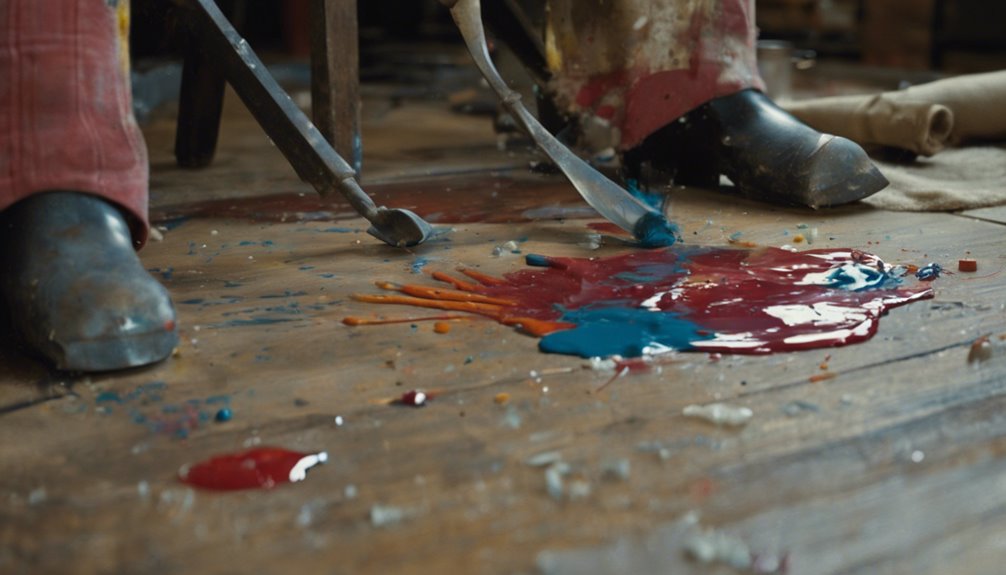To remove paint from your floor, start by identifying your floor type—hardwood or tile. Gather essential tools like a scraper, paint remover, gloves, and drop cloths. Test a few paint removal methods, such as vinegar or rubbing alcohol, to see what works best. Use a sharp scraper at a slight angle to lift the paint without damaging the surface. After removal, clean the area thoroughly and allow it to dry. With the right approach, you can restore your floor's appearance. If you're curious about additional techniques and tips, there's more to explore for a successful restoration.
Identify the Floor Type
Before you tackle the task of removing paint from your floor, it's crucial to identify the type of flooring you have. Knowing whether you've got hardwood floors or tile surfaces will guide your approach. Hardwood floors are sensitive to harsh chemicals and excessive moisture, so you'll want to choose a method that's safe and effective without damaging the wood. On the other hand, tile surfaces are typically more durable and can withstand stronger cleaning agents, making it easier to remove paint.
Assessing your floor type helps you determine the right tools and techniques, ensuring you won't accidentally ruin your beautiful floors in the process. Taking a moment to identify the flooring will save you time and effort down the line.
Gather Necessary Tools
Once you've identified your floor type, it's time to gather the necessary tools for the job. Having the right paint removal tools and safety equipment will make the process smoother and safer. Here's a quick list to help you prepare:
- Scraper or putty knife: Perfect for lifting paint off the surface.
- Paint thinner or remover: Essential for breaking down stubborn paint.
- Protective gloves and goggles: Keep your hands and eyes safe from chemicals.
- Drop cloths or plastic sheeting: Protect surrounding areas from paint splatters.
With these tools in hand, you'll be ready to tackle the job efficiently. Remember, safety first—don't skip the protective gear! Enjoy the freedom of a clean floor without the hassle of old paint.
Test Paint Removal Methods
As you prepare to remove paint from your floor, it's wise to test a few methods on a small, inconspicuous area first. Different paint types can present unique removal challenges, so it's important to find the right approach. Here's a quick comparison of common methods:
| Method | Effectiveness | Cautions |
|---|---|---|
| Vinegar | Moderate | May require scrubbing |
| Rubbing Alcohol | High | Flammable, use with care |
| Commercial Remover | Very High | Test on surface first |
Use Scrapers and Putty Knives
Start by grabbing a scraper or putty knife to tackle the paint on your floor. These tools can be incredibly effective when used properly. Here are some tips for successful scraper techniques and putty knife usage:
- Choose a scraper with a sharp blade for better results.
- Hold the scraper at a slight angle to lift the paint without damaging the floor.
- Use a putty knife for detailed areas or stubborn spots.
- Apply consistent pressure, working slowly to avoid gouging the surface.
With a bit of patience and the right techniques, you'll see the paint lift away. Enjoy the freedom of a clean floor as you reclaim your space!
Apply Chemical Paint Removers
Applying chemical paint removers can be an effective way to tackle stubborn paint stains on your floor. Start by selecting a suitable product, ensuring it's designed for your flooring type. Before you begin, prioritize chemical safety: wear gloves, goggles, and a mask to protect yourself from fumes. Apply the remover according to the manufacturer's instructions, usually starting with a small area to test its paint removal effectiveness. Allow it to sit for the recommended time, then gently scrape or wipe away the softened paint. Rinse the area thoroughly to remove any residue. Remember, proper ventilation is key while using these chemicals, so open windows and doors to keep the air fresh and safe. Enjoy your newly restored floor!
Try Heat Gun Techniques
Using a heat gun can be an effective technique for removing paint from your floor, especially for thicker layers. This method allows you to soften the paint, making it easier to scrape off. However, it's essential to prioritize heat gun safety during the process.
- Keep the heat gun moving to prevent scorching the floor.
- Work in small sections for better control.
- Use a putty knife to gently lift the softened paint.
- Guarantee proper ventilation to avoid inhaling fumes.
Consider Sanding Options
While a heat gun can effectively soften paint for removal, sanding is another viable option, especially for tougher surfaces or stubborn spots. You'll need the right sanding equipment, like an orbital sander or a sanding block, to tackle this task. Start by choosing the appropriate sanding technique: for large areas, an electric sander will save you time, while a manual block can give you more control on intricate sections. Use coarse grit sandpaper initially to remove the bulk of the paint, then switch to finer grit for a smoother finish. Remember to wear a mask and goggles to protect yourself from dust. Sanding not only removes paint but also prepares your floor for a fresh look.
Clean and Restore the Surface
After you've successfully removed the paint, it's essential to clean and restore the surface to guarantee it looks its best. Proper surface preparation guarantees a fresh canvas for any future projects. Start by using effective cleaning solutions suited for your floor type. Here's what you should do:
- Sweep or vacuum to remove dust and debris.
- Mix your cleaning solution according to the manufacturer's instructions.
- Mop the floor thoroughly, focusing on any stubborn areas.
- Rinse with clean water to remove any residue.
Once the floor is clean, let it dry completely before applying any sealants or finishes. This step not only enhances the appearance but also helps maintain the integrity of your flooring for years to come.
Prevent Future Paint Spills
To prevent future paint spills, it is crucial to take a few proactive steps before starting any painting project. First, always gather necessary supplies, including brushes, rollers, and trays, to minimize the chance of accidents. Use protective coverings like drop cloths or plastic sheets to shield your floors and furniture from potential splatters. Secure these coverings with tape to keep them in place. Additionally, consider using painter's tape to mask off areas where you don't want paint. When pouring paint, do it slowly to avoid overfilling your containers. Finally, keep your workspace organized—having everything in its place reduces the risk of knocking over paint cans. By implementing these preventive measures, you can enjoy your painting project without the worry of spills.
Frequently Asked Questions
Can I Use Vinegar to Remove Paint From Floors?
You're wondering if vinegar's effective for removing paint from floors. While vinegar can help soften some types of paint, it might not be the best solution for tougher jobs. It works well on fresh spills, but for dried paint, you might want to evaluate alternative solutions like rubbing alcohol or commercial paint strippers. Always test in a small area first to avoid damage and ascertain you choose the best method for your flooring type.
Is It Safe to Use Paint Thinner Indoors?
Using paint thinner indoors isn't recommended due to its strong fumes, which can be harmful without proper ventilation. If you're considering it, guarantee you have ample indoor ventilation, like open windows or fans. However, you might want to explore paint thinner alternatives, such as citrus-based solvents or vinegar, which are safer options. These alternatives can effectively help with your projects while minimizing health risks, allowing you to work freely and comfortably.
How Long Does It Take for Paint Remover to Work?
When you're using paint remover, its effectiveness can vary, but you can generally expect it to start working within 15 to 30 minutes. However, drying time is vital; letting it sit longer may enhance results, especially for thicker layers. Always check the product instructions for specific recommendations. Remember, patience is key to achieving the best outcome, so don't rush the process if you want to guarantee successful paint removal.
Will Removing Paint Damage My Floor Finish?
You might worry that removing paint could damage your floor finish, and it's a valid concern. Different floor types react differently; for instance, hardwood is more sensitive than tile. If you've got a delicate paint finish, using harsh chemicals could cause damage. Instead, opt for gentle removers or methods tailored to your specific flooring. Always test in a small area first to guarantee you maintain your floor's integrity while achieving freedom from unwanted paint.
What Should I Do if the Paint Won't Come Off?
If the paint won't come off, don't worry! You've got options. Start by trying different paint removal methods like using a heat gun or a solvent-based remover. For stubborn paint solutions, consider rubbing alcohol or vinegar, which can break down the paint effectively. Always test a small area first to avoid damage. If all else fails, sanding might be necessary, but take care to protect your surface and finish.




